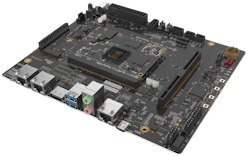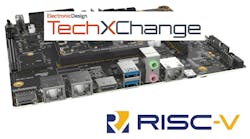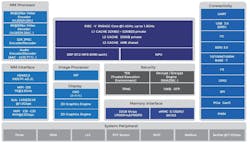RISC-V Board Backs Developers of Embedded Apps
SiFive released its HiFive Premier P550 Development Board (Fig. 1) targeted at embedded application developers. It leverages a quad-core RISC-V SoC from ESWIN Computing that incorporates an Imagination GPU and an ESWIN neural processing unit (NPU). The module plugs into the motherboard that implements a standard PC layout and power connection along with a PCI Express slot.
The miniDTX motherboard has a pair of gigabit Ethernet ports for the host and a remote debug Ethernet port. There are five exposed USB 3 ports plus a 6-GB/s SATA3 connection and an M.2 E-Key PCIe Gen 3 socket populated with a Wi-Fi/Bluetooth module. The system comes installed with Ubuntu 24.04 and a complete tool suite to support native RISC-V development.
“The collaboration between ESWIN Computing, SiFive, and Canonical to bring Ubuntu 24.04 to the HiFive Premier P550 highlights the core values of RISC-V: openness and collaboration,” said Gordan Markuš, Director of Silicon Alliances at Canonical. “The HiFive Premier P550 stands out as the premium development board for enthusiasts and developers, helping drive the next wave of cutting-edge RISC-V development. We’re proud to see Ubuntu Linux as a key enabler of this innovation and development on the Premier P550 board.”
More RISC-V Articles
The ESWIN chip's (Fig. 2) RISC-V RV64GBC ISA core is based on SiFive's P550 architecture that implements a 13-stage, triple-issue, out-of-order pipeline. The module has 128 GB of eMMC flash memory and either 16 or 32 GB of DDR5 memory.
The compute engine includes the quad-core RISC-V processors, a DSP, and the NPU. Software support for the latter will be coming shortly. The NPU can deliver 19.95 TOPS for INT8-based machine-learning models. This includes large language model (LLM) support for frameworks such as TensorFlow, PyTorch, and PaddlePaddle.
The SoC incorporates 8K 25-frame/s video encoders and 8K 50-frame/s decoders along with JPEG encode/decode and audio encode/decode that support standards like AAC.
The video interface features HDMI 2.0 with HDCP 1.4 and 2.2 support, MIPI-DSI, and LVDS along with MIPI CSI C/D camera inputs. There's a built-in image signal processing (ISP) unit. The Imagination GPU provides 2D and 3D support.
Secure boot with a trusted execution environment (TEE) are supported by the security engine. It has its own true random number generator (TRNG) plus 16 KB of one-time-programmable (OTP) memory.
The typical power requirement for the EIC7700X chip is 8 W.
More RISC-V Articles and TechXchanges
About the Author
William G. Wong
Senior Content Director - Electronic Design and Microwaves & RF
I am Editor of Electronic Design focusing on embedded, software, and systems. As Senior Content Director, I also manage Microwaves & RF and I work with a great team of editors to provide engineers, programmers, developers and technical managers with interesting and useful articles and videos on a regular basis. Check out our free newsletters to see the latest content.
You can send press releases for new products for possible coverage on the website. I am also interested in receiving contributed articles for publishing on our website. Use our template and send to me along with a signed release form.
Check out my blog, AltEmbedded on Electronic Design, as well as his latest articles on this site that are listed below.
You can visit my social media via these links:
- AltEmbedded on Electronic Design
- Bill Wong on Facebook
- @AltEmbedded on Twitter
- Bill Wong on LinkedIn
I earned a Bachelor of Electrical Engineering at the Georgia Institute of Technology and a Masters in Computer Science from Rutgers University. I still do a bit of programming using everything from C and C++ to Rust and Ada/SPARK. I do a bit of PHP programming for Drupal websites. I have posted a few Drupal modules.
I still get a hand on software and electronic hardware. Some of this can be found on our Kit Close-Up video series. You can also see me on many of our TechXchange Talk videos. I am interested in a range of projects from robotics to artificial intelligence.







